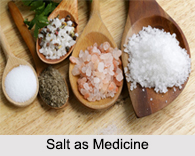 Salt has been widely used as a medicine since the ancient times by physicians across the world. Sushruta describes the following varieties of salts, namely;
Salt has been widely used as a medicine since the ancient times by physicians across the world. Sushruta describes the following varieties of salts, namely;
•Saindhava
•Samudra
•Vit
•Sauvarchala
•Romaka
•Audbhida
•Gutika
•Pansuja also called Ushasuta
Benefits of Salt
The first five in the above list generally pass by the name of "Pancha Lavana" or the five salts, and are often used in combination. The other varieties are rarely used in medicine.
Saindhava literally means produced in Sindhu, or the country along the Indus. The term is applied to rock salt which is regarded as the best of salts. Three varieties of rock salt are recognized, namely, white, red and crystalline. The pure white crystalline salt is preferred for medicinal use. For alimentary purposes also, rock salt is considered superior to the other varieties. It is regarded as digestive, appetizing, sweet and agreeable, and is much used in dyspepsia and other abdominal diseases.
Samudra literally means produced from the sea. The term is applied to sun-dried sea salt and is called karkach in the vernacular. Sun-dried sea salt is described as somewhat bitter and laxative. In other respects its properties are said to resemble those of rock salt.
Vit Lavana occurs in dark red shining granules somewhat resembling coarsely powdered lac in appearance. It has a mild, saline and somewhat nauseous taste. It is said to be carminative and stomachic, and to be useful in enlarged spleen, dyspepsia, indigestion, bowel complaints, etc.
Sauvarchala, also called sonchal or kalanimak in Hindi is said to be aromatic, agreeable and digestive, and useful in the some sort of cases as vitlavana.
Romaka is the salt produced from the Sambar Lake near Ajmer. The name Romaka is said to be derived from a river called Ruma. It is obtained by the evaporation of salt water in the shape of clear rhomboidal crystals. It has a pungent taste, and is considered laxative and diuretic, in addition to possessing the other properties of salts. It is said to be the best and purest of evaporated salts.
Audbhid, which is produced of itself from the earth is the name applied to a salt produced as efflorescence on reh lands. It is described as alkaline, bitter, pungent and nauseating.
Gutika, this salt is mentioned by Sushruta as stomachic, digestive and laxative.
Patisuja or Ushasuta literally means salt manufactured from saline earth. Panga or common salt, manufactured from earth impregnated with salt water, would come under this head.
Dose of Salt in Medicine
Rock salt with warm water is used as an emetic. The different varieties of salt enter into the composition of a great many medicines for dyspepsia, indigestion, enlarged spleen and other tumours in the abdomen. The following are a few illustrations.
Narikelakshara: Take a coconut fruit full of water, make a hole in it and fill the coconut with rock salt and dissolve the salt in its water. Then close the opening, cover the nut with a layer of clay and roast it in a pit of fire. The salt thus roasted is esteemed as a valuable medicine in the form of dyspepsia which is attended with pain. It is given with the addition of long pepper.
Bhaskara Lavana: Take karkach salt 16 tolas, sonchal salt 10 tolas, black salt, rock salt, coriander, long pepper, long pepper root, leaves called tejpatra, seeds of Nigella, scitida (krishnajiraka), leaves of Pinus Webbiana (talisa patra), flowers of Mesua ferrea (nagakesara), fruits of Calamus fasciculatus (amlaveasa), 4 tolas each, black pepper, cumin seeds and ginger, 2 tolas each, pomegranate seeds 8 tolas, cinnamon and cardamoms one tola each, powder, mix and soak 7 times in lemon juice. Dose should be about a drachm with whey or wine, in enlarged spleen and other tumours in the abdomen, dyspepsia, loss of appetite, constipation, etc.
Rock salt is applied to opacities on the cornea, either singly or in combination with other drugs, as in the following. Take the seeds of Acacia Lebbek (Sirisa), long pepper, black pepper and rock salt in equal parts, rub them together with water, and make into pellets or pencils. These are rubbed on opacities of the cornea.





